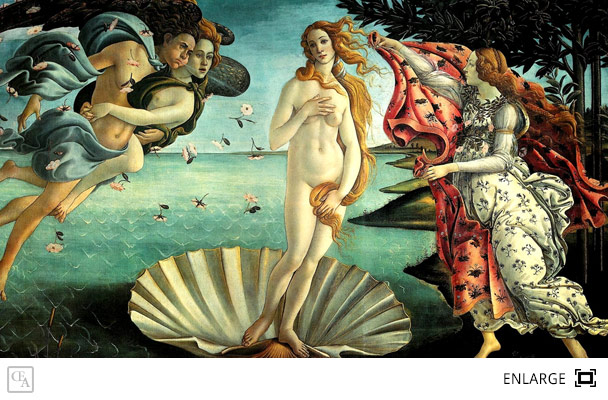
The work was painted by Sandro Botticelli, who also created another major Renaissance work, Primavera (alternatively known as Allegory of Spring).
Of interesting note is the medium that Botticelli chose to paint on, which was canvas. Typically during this era, artists used wood panels, and though this trend would continue for well over another century, the use of canvas was slowly gaining more popularity. Canvas was more practical and durable particularly in moist climates like those in Southern Italy, while wood was not only costlier, but tended to deteriorate faster in the humidity. While wood was still considered more favorable for formal or official locations, canvas began to find a niche in the private, more casual market.
Botticelli chose the particular subject of Venus's creation likely as an homage to the works of Homer. In the myths, Venus traveled to Cythera on top of a seashell soon after her birth. Zephyrus, the god of the wind, helps to send Venus on her course by blowing her towards the island. In his arms is Aura, and they are both surrounded by pink flowers that float (or fall) in the air around them. A goddess character, most likely Pomona, wearing a white dress with an organic pattern, is seen standing on land, awaiting the arrival of Venus and holding a large reddish drapery of sorts that flutters in the wind. The ocean seems oddly small and calm compared to the figures in the painting, its waves tiny and splashing lightly against the shore of the island. The only other life in the painting are the reeds near the shore and the strangely straight-trunked trees behind Pomona.
This work shares some compositional similarities with Primavera, and includes Zephyrus in a similar pose, his cheeks puffed out as he blows the wind towards the other subjects of the painting. Both deal with themes of creation and fertility.
Venus herself appears inhumanly pristine in the painting, free of any marks or imperfections marring her face or body, and her skin is milky in its glowing paleness. Botticelli used dark lines to contour the curves of her body in order to make her form pop out more easily from the background and in order for her white skin to have a kind of contrast. Her hair is long and flowing, typical of the style that women tended to wear during the era in which the work was painted. Interestingly, Venus is naked, only her long hair slightly covering her nudity, contrasting the tendency to always drape female figures in art during the Middle ages. Botticelli likely used a statue of Aphrodite as his model for the painting, and it shows in her sculpture-like pose and looks.
 Arts3 Network
Website edition
Arts3 Network
Website edition